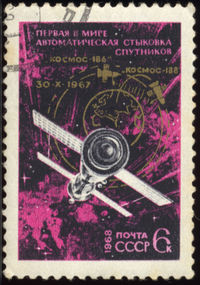
Cosmos 186 and Cosmos 188
Encyclopedia

Soyuz programme
The Soyuz programme is a human spaceflight programme that was initiated by the Soviet Union in the early 1960s, originally part of a Moon landing project intended to put a Soviet cosmonaut on the Moon...
descent module for landing scientific instruments and test objects. The two USSR spacecraft made the first fully automated space docking in the history of space exploration
Space exploration
Space exploration is the use of space technology to explore outer space. Physical exploration of space is conducted both by human spaceflights and by robotic spacecraft....
on October 30, 1967. Mutual search, approach, mooring, and docking were automatically performed by the IGLA-system on board Kosmos 186. After 3.5 h of joint flight, the satellites parted on a command sent from the earth and continued to orbit separately. Both made a soft landing in a predetermined region of the USSR - Kosmos 186 on October 31, 1967 and Kosmos 188 on November 2, 1967.
Because of the lethal outcome of both the Soyuz 1
Soyuz 1
Soyuz 1 was a manned spaceflight of the Soviet space program. Launched into orbit on April 23, 1967 carrying cosmonaut Colonel Vladimir Komarov, Soyuz 1 was the first flight of the Soyuz spacecraft...
and the US Apollo 1
Apollo 1
Apollo 1 was scheduled to be the first manned mission of the Apollo manned lunar landing program, with a target launch date of February 21, 1967. A cabin fire during a launch pad test on January 27 at Launch Pad 34 at Cape Canaveral killed all three crew members: Command Pilot Virgil "Gus"...
missions earlier that year it was decided to proceed with unmanned flights first. But because the USSR had no ground stations outside its own territory, this meant the docking had to be done fully automated. After the first attempt failed (a fly-by at a distance of 900 m), the second attempt succeeded over the South Atlantic. However, this docking was not entirely successful either - the modules were mechanically docked, but not electrically. Also, the manoeuvre had cost more fuel than anticipated.
This mission proved it possible to launch smaller parts and assemble them in space, thus eliminating the need for exceedingly large rockets for larger undertakings like a space station
Space station
A space station is a spacecraft capable of supporting a crew which is designed to remain in space for an extended period of time, and to which other spacecraft can dock. A space station is distinguished from other spacecraft used for human spaceflight by its lack of major propulsion or landing...
.
| Mission parameters | ||
|---|---|---|
| Kosmos 186 | Kosmos 188 | |
| Spacecraft | Soyuz 7K-OK (A) | Soyuz 7K-OK(P) |
| Mass | 6,530 kg | 6,530 kg |
| Crew | None | None |
| Launched | 27 October 1967, 09:30:00 UTC Baikonur Baikonur Cosmodrome The Baikonur Cosmodrome , also called Tyuratam, is the world's first and largest operational space launch facility. It is located in the desert steppe of Kazakhstan, about east of the Aral Sea, north of the Syr Darya river, near Tyuratam railway station, at 90 meters above sea level... , launch pad n. 31 |
30 October 1967, 08:09:00 UTC Baikonur Baikonur Cosmodrome The Baikonur Cosmodrome , also called Tyuratam, is the world's first and largest operational space launch facility. It is located in the desert steppe of Kazakhstan, about east of the Aral Sea, north of the Syr Darya river, near Tyuratam railway station, at 90 meters above sea level... , launch pad n. 1 |
| Landed | 31 October 1967, 08:20 UTC | 2 November 1967, 09:10 UTC |
| Flight duration | 3 days, 22 h, 50 min | 3 days, 1 h, 1 min |
| Perigee | 172 km | 180 km |
| Apogee | 212 km | 247 km |
| Inclination | 51.7° | 51.7° |
| Period | 88.7 minutes | 89.0 minutes |
| NSSDC ID | 1967-105A | 1967-107A |

